
|
Sale 114
The New York Sale
| Lot |
Photo |
Description |
Bidding |
Lot 179 |
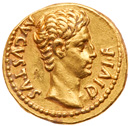 |
Augustus. Gold Aureus (7.92 g) 27 BC - 14 AD. Mint of Lugdunum (Lyons), struck 15-12 BC. AVGVSTVS DIVI F, Bare head of Augustus right. Reverse: Bull butting right, IMP X in ex. (RIC 166a, Bahrfeldt 201, BM 450, Calicó 212, Cohen 136, BMCRE 450; Giard, Lyon 18, pl IX). Accompanied by a certificate of Authenticity by David Sear and an ANACS photo certificate. Boldly struck on a nice broad flan. We note a small mark in the field behind the neck of Augustus. Extremely Fine. Value $7,000 - UP
View details and enlarged photos
|
|
Lot 180 |
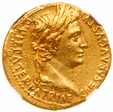 |
Augustus. Gold Aureus (7.85 g), 27 BC-AD 14. Lugdunum, 2 BC-AD 12. CAESAR AVGVSTVS DIVI F PATER PATRIAE, laureate head of Augustus right. Reverse: AVGVSTI F COS DESIG PRINC IVVENT, Caius and Lucius Caesars standing facing, shields and spears between them; above, between the spears, simpulum and lituus turned inwards: C L CAESARES in exergue. RIC 206; Lyon 81; BN 1648-50; BMC 513-8; Calicó 176a. NGC grade AU; Strike: 5/5, Surface: 3/5, Marks. Value $7,500 - UP
Ex Künker 42 (12 March 1998), 3054.
View details and enlarged photos
|
|
Lot 181 |
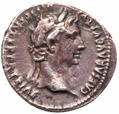 |
Augustus, with Tiberius, Caesar. Silver Denarius (3.70 g), 27 BC-AD 14. Lugdunum, AD 13/4. CAESAR AVGVSTVS DIVI F PATER PATRIAE, laureate head of Augustus right. Reverse: TI CAESAR AVG F TR POT XV, bare head of Tiberius right. RIC 226; Lyon 88; BN 1682-4; BMC 507; RSC 2. Toned. Very Fine. Value $1,000 - UP
View details and enlarged photos
|
|
Lot 182 |
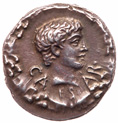 |
Caius. Silver Denarius (3.70 g), Caesar, 20 BC-AD 4. Uncertain mint, ca. 17 BC. CA-ES-AR, bare head of Caius right within oak wreath. Reverse: AVGVSTVS, candelabrum ornamented with rams' heads; all within wreath entwined with bucrania and patera. RIC 540; BMC 684; RSC 2. Boldly struck in high relief, excellent metal and attractively toned. Superb Extremely Fine. Value $10,000 - UP
The portrait on this enigmatic issue was originally attributed by Cohen to Caius Caesar, the grandson and, along with his younger brother Lucius, adoptive co-heir of Augustus. Mattingly however, in RIC 1 (1st ed.) identified the portrait as being of Augustus. The youthful features do not resemble those of Rome's first citizen, and the fact that the coin was struck the same year that Augustus elevated his grandsons as his heirs suggests that the portrait indeed represents the elder grandson.
View details and enlarged photos
|
|
Lot 183 |
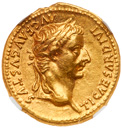 |
Tiberius. Gold Aureus (7.82 g) AD 14-37. Mint of Lugudnum. TI CAESAR DIVI AVG F AVGVSTVS, laureate head facing right. Reverse: PONTIF MAXIM, Female figure (Livia?) seated right, holding a sceptre and a branch (RIC 29; BMC 46; Calicó 305c). A superb example, fully lustrous and struck on a broad flan, excellent portrait, a simply superb example. NGC graded MS*, Strike 5/5 Surface 4/5. Value $15,000 - UP
View details and enlarged photos
|
|
Lot 184 |
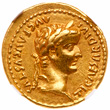 |
Tiberius. Gold Aureus (7.74 g), AD 14-37. 'Tribute Penny' type. Lugdunum, AD 15-18. TI CAESAR DIVI AVG F AVGVSTVS, laureate head of Tiberius right. Reverse: PONTIF MAXIM, Livia, as Pax, seated right on chair with plain legs, holding scepter and olive branch. RIC 25; Lyon 143; BN 13-5; BMC 30-3; Calicó 305d. NGC grade Ch XF; Strike: 5/5, Surface: 4/5. Value $7,500 - UP
View details and enlarged photos
|
|
Lot 185 |
 |
Tiberius. Gold Aureus (7.78 g), AD 14-37. 'Tribute Penny' type. Lugdunum, AD 18-35. TI CAESAR DIVI AVG F AVGVSTVS, laureate head of Tiberius right. Reverse: PONTIF MAXIM, Livia, as Pax, seated right on chair with ornate legs, holding scepter and olive branch. RIC 29; Lyon 151; BN 32; BMC 47; Biaggi 170; Calicó 305a. NGC grade XF; Strike: 5/5, Surface: 3/5. Scratches. Value $5,000 - UP
View details and enlarged photos
|
|
Lot 186 |
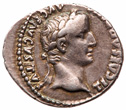 |
Tiberius. Silver Denarius (3.83 g), AD 14-37. Lugdunum, AD 15/6. TI CAESAR DIVI AVG F AVGVSTVS, laureate head of Tiberius right. Reverse: TR POT XVII around, IMP VII in exergue, Tiberius, holding olive branch and eagle-tipped scepte, rdriving slow quadriga right. RIC 4; Lyon 122; BN 5-8; BMC 7-11; RSC 48. Choice Very Fine. Value $1,000 - UP
View details and enlarged photos
|
|
Lot 187 |
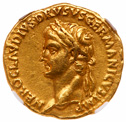 |
Nero Claudius Drusus. Gold Aureus (7.82 g), died 9 BC. Lugdunum, under Claudius, AD 41/2. NERO CLAVDIVS DRVSVS GERMANICVS IMP, laureate head of Nero Claudius Drusus left. Reverse: DE / GERM above and on architrave, triumphal arch surmounted by equestrian statue between two trophies. RIC 69; BN 95; BMC 95; CNR 2/3 (this coin); Calicó 315. NGC grade Ch XF; Strike: 5/5, Surface: 4/5. Value $20,000 - UP
Nero Claudius Drusus was the son of Livia and the senator Tiberius Claudius Nero. Before he was born his parents divorced so that Augustus could marry his mother. Unlike his older brother, the future emperor Tiberius whom Augustus disliked, the emperor doted on his younger stepson. In 13 BC Drusus was sent to govern Gaul, and while there he repelled an attack by a tribe of Germans who had invaded the province. Most of the following years until his death were spent on campaigns in German territory. First, he crossed the Rhine frontier and penetrated as far as the North Sea, subduing the Frisii. The following years saw him engaged against various confederations of the Chatti, Sicambri and Marcomanni. He died tragically in 9 BC from injuries he sustained when he fell from his horse while on campaign fighting the Marcomanni.The Arch of Drusus that appears on the reverse of this coin and which commemorated his campaigns in Germania has not survived. Its precise location is not known, but it was on the Appian way.
Ex Nelson Bunker Hunt Collection, pt. IV (Sotheby's, New York, 20 June 1991), 686; Ex J. H. Barnes Collection (Sotheby's, London, 26 June 1974), 5.
View details and enlarged photos
|
|
Lot 188 |
 |
Nero Claudius Drusus. Silver Denarius (3.74 g), died 9 BC. Lugdunum, under Claudius, AD 41/2. NERO CLAVDIVS DRVSVS GERMANICVS IMP, laureate head of Nero Claudius Drusus left. Reverse: DE / GERM above and on architrave, triumphal arch surmounted by equestrian statue between two trophies. RIC 70; BN 3; BMC 97; RSC 2. Very Rare. NGC grade XF; Strike: 5/5, Surface: 3/5. Value $2,500 - UP
View details and enlarged photos
|
|
Lot 189 |
 |
Antonia Minor, patriarch of the Claudians, Gold Aureus (7.73 g), Augusta, AD 37 and 41. Rome, under Claudius, ca. AD 41-45. ANTONIA AVGVSTA, draped bust of Antonia right, wreathed with ears. Reverse: CONSTANTIAE AVGVSTI, Antonia, as Constantia, standing facing, holding long torch and cornucopia. RIC 65; BN 12; BMC 109; Calicó 318. Extremely Rare. NGC grade Ch VF; Strike: 5/5, Surface: 3/5. Edge cut. Value $15,000 - UP
Antonia was the younger daughter of Mark Antony and Octavia in 36 BC. In either 18 or 16 BC, she married Nero Claudius Drusus, to whom she bore three children: Germanicus, Livilla and Claudius. Although initially honored with the title of Augusta by her grandson, Caligula, she eventually fell out of favor with him, committing suicide in AD 37 possibly as a result. Her son Claudius reconfirmed the title on her posthumously in AD 41.
Ex Hirsch 193 (19 February 1997), 26; Ex H. Osborne O'Hagan Collection (Sotheby, Wilkinson & Hodge, 17 July 1908), 78.
View details and enlarged photos
|
|
Lot 190 |
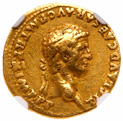 |
Claudius. Gold Aureus (7.77 g), AD 41-54. Rome, AD 50/1. TI CLAVD CAESAR AVG P M TR P X IMP P P, laureate head of Claudius right. Reverse: PACI AVGVSTAE, Pax-Nemesis advancing right, pointing winged caduceus at serpent before, and holding out fold of drapery at neck. RIC 51; BMC 61; Calicó 383. NGC grade VF; Strike: 5/5, Surface: 3/5. Marks. Value $5,000 - UP
This fine aureus of Claudius minted in AD 50/1 features on the reverse the figure of the winged goddess Nemesis with a serpent at her feet. Nemesis was associated with the concept of righteous retribution. As the type occurs regularly on the precious metal coinage of this reign, it was clearly intended to symbolize a fundamental aspect of the emperor's personal policy. Doubtless, it was this idea that was invoked as a justification for the invasion and conquest of Britain commencing in AD 43 and perhaps also for the execution of his wife Messalina half a decade later.
View details and enlarged photos
|
|
Lot 191 |
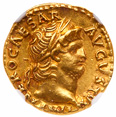 |
Nero. Gold Aureus (7.27 g), AD 54-68. Rome, ca. AD 66/7. IMP NERO CAESAR AVGVSTVS, laureate head of Nero right. Reverse: SALVS in exergue, Salus seated left, holding patera. RIC 66; BN 236; BMC 94; Calicó 445. Superb details, excellent style. Boscoreale patina. NGC grade AU; Strike: 5/5, Surface: 3/5. Scratch. Value $12,500 - UP
Ex J. Hirsch XXVI (24 May 1910), 677.
View details and enlarged photos
|
|
Lot 192 |
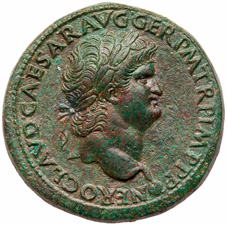 |
Nero. Æ Sestertius (27.76 g), AD 54-68. Lugdunum, AD 65. NERO CLAVD CAESAR AVG GER P M TR P IMP P P, laureate head of Nero right. Reverse: S C across field, statuary group of the emperor in quadriga flanked by Victory and Pax atop triumphal arch; at cornices, soldiers or torch bearers; in side niche of arch, statue of Mars holding spear. RIC 392; WCN 410; Lyon 70; BN 77; BMC 329. A stunning example. Glossy reddish-green patina. Extremely Fine. Value $5,000 - UP
View details and enlarged photos
|
|
Lot 193 |
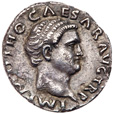 |
Otho. Silver Denarius (3.22 g), AD 69. Rome. IMP M OTHO CAESAR AVG TR P, bare head of Otho right. Reverse: VICTORIA OTHONIS, Victory advancing right, holding wreath and palm. RIC 14; BN 19; BMC 22; RSC 27. Wonderful bold portrait. Edge a bit rough. Rarely seen this choice. Toned. Extremely Fine. Value $3,000 - UP
Ex Gemini XII (11 January 2015), 352; Ex Gemini IX (8 January 2012), 268; Ex Monetarium 60 (1993), 99.
View details and enlarged photos
|
|
Lot 194 |
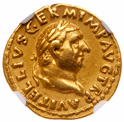 |
Vitellius. Gold Aureus (7.29 g), AD 69. Rome. A VITELLIVS GERM IMP AVG TR P, laureate head of Vitellius right. Reverse: CONCOR-DIA PR, Concordia seated left, holding patera and cornucopiae. RIC 89; BN 51; BMC 8; Mazzini 17 (this coin); Calicó 542. Very Rare. NGC grade Ch VF; Strike: 5/5, Surface: 3/5. Graffito. Value $20,000 - UP
Vitellius was made Governor of Lower Germany by Galba. When the legions became disaffected from Galba's austere and strict rule, they renounced their allegiance to him and hailed Vitellius as emperor. Vitellius at first refused the imperial title, but he did take the name Germanicus and pledged to lead the revolt. Shortly thereafter the provinces of Britain, Gaul and Spain defected to him. Meanwhile in Rome, Galba had been murdered and Otho installed as the new emperor by the Praetorian Guard.
Otho offered to share the emperorship with Vitellius, but the latter, whose forces were already marching on Rome, refused. A decisive engagement, the Battle of Bedriacum, was fought between the two sides in the vicinity between Cremona and Verona, and Vitellius's forces were victorious. Despite losing at Bedriacum, Otho perhaps could still have won the war - he had the support of the formidable legions of Dalmatia, Moesia and Pannonia, as well as both the Praetorian Guard and the Roman fleet - but instead chose to avoid civil war by committing suicide.
Once in Rome the Senate decreed Vitellius the usual imperial honors. The historians Suetonius, Tacitus and Dio Cassius do not record much positive about Vitellius's short reign, but he did implement some worthwhile and lasting changes (for instance, he accepted equites into the offices of imperial administration whereas before they had been open only to freedmen). Overall, though, his reign was irresolute, and Vitellius himself is described as lazy and self-indulgent.
Ex Gorny & Mosch 224 (13 October 2014), 473 (hammer: EUR 20,000); Ex Giuseppe Mazzini (1883�1961) Collection, Vol. 1 (Milan 1957), p. 180, pl. LXIV, 17.
View details and enlarged photos
|
|
Lot 195 |
 |
Vitellius. Silver Denarius (3.29 g), AD 69. Rome. A VITELLIVS GERM IMP AVG TR P, laureate head of Vitellius right. Reverse: XV VIR SACR FAC, tripod with covered vessel; below, raven standing right; above, dolphin to right. RIC 109; BN 77; BMC 39; RSC 111. Attractive old cabinet toning. NGC grade Ch AU; Strike: 4/5, Surface: 4/5. Fine style. Value $4,000 - UP
View details and enlarged photos
|
|
Lot 196 |
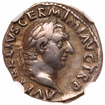 |
Vitellius. Silver Denarius (3.32 g), AD 69. Rome. A VITELLIVS GERM IMP TR P, laureate head of Vitellius right. Reverse: XV VIR SACR FAC, tripod with covered vessel; below, raven standing right; above, dolphin to right. RIC 109; BN 77; BMC 39; RSC 111. Pleasing old cabinet tone. NGC grade VF; Strike: 5/5, Surface: 4/5. Value $1,750 - UP
Ex Prinz Philipp von Sachsen Coburg Gotha Collection (L. Hamburger, 20 February 1928), 449.
View details and enlarged photos
|
|
Lot 197 |
 |
Vespasian, with Titus, as Caesar. Gold Aureus (7.69 g), AD 69-79. Minted in Alexandria, Egypt after the fall of Jerusalem, AD 70. IMP CAESAR VESPASIANVS AVG, laureate head of Vespasian right. Reverse: IMP T FLAVIVS CAESAR AVG F, laureate head of Titus right. RIC 1528; BN 314; BMC 496; RPC 1906.5 (this coin); Calicó 711. Extremely Rare. Luster present. Superb Extremely Fine. Value $50,000 - UP
In June of AD 69, Vespasian, the Roman commander of the ongoing repression of the Jewish Revolt had delegated the siege of Jerusalem to his son, Titus, so that he could proceed to Rome and claim the disputed imperial purple for himself. He advanced to Egyptian Alexandria in order to take ship to Rome, but was prevented from immediate departure by storms. Vespasian was still in Alexandria in December of AD 69, when he learned that his rival Vitellius had been defeated and that the Senate recognized him as Augustus.
The new emperor remained in the city well into AD 70, in order to solidify his support at the source of Rome's grain supply and to quell a revolt that erupted due to a series of unfavorable tax reforms. In an effort to recoup financial losses incurred by the treasury during the Year of the Four Emperors, Vespasian imposed a variety of taxes, the most odious of which was the vectigal urinae, a urine tax on public toilets. Even Titus is said to have thought this tax was taking things a little too far, but when he complained to his father, Vespasian is said to have told him to smell the money collected from the tax, noting that it did not stink even though it was derived from urine. Nevertheless, the new taxation regime caused disturbances in Alexandria and briefly halted grain shipments to Rome. Vespasian's settling of the problem as well as rumors that he was blessed by the Egyptian gods and had miraculous healing powers added to his public image as a savior of the Rome and the Empire.
Vespasian had reached Rome by the middle of AD 70 and on August 30 of the same year Titus captured and destroyed Jerusalem, thereby ending the Jewish Revolt for all intents and purposes. After a period of celebratory traveling through Syria and a diplomatic meeting with Vologases I, the king of the Parthian Empire, Titus followed his father to Alexandria in order to sail for Rome. However, he caused some concern when he visited Memphis and wore a traditional diadem to consecrate the sacred Apis bull. The wearing of the diadem smacked of kingship and resulted in suspicion that he might rebel against his father.
The present aureus, which features wonderfully veristic portraits of Vespasian and Titus was undoubtedly struck in Alexandria when the victorious Titus was present in AD 70 waiting to return to Rome, if not already when Vespasian had stayed in the city. Titus was proclaimed Caesar by the Senate at the same time that his father was recognized as Augustus. On both occasions it would have been necessary to strike gold and silver coins to cement the loyalty of the Alexandrian elite and especially the legions stationed there. In the aftermath of the conquest of Judaea, Titus also would have been distributing celebratory largesse, some of which was probably struck from the spoils of Jerusalem.
While Titus was in Alexandria, one wonders whether the double portrait type of this coin may have fueled the reported rumors claiming that he planned revolt against his father. The types depict Vespasian and Titus as virtual equals, both wearing the laurel wreath typical of emperors and the only indicator that Titus was not a full equal comes at the end of his titulature. Whereas Vespasian is AVG (Augustus), Titus is merely AVG F (filius Augusti, i.e., "son of the Augustus"). The fact that only a single letter stood in the way of rebellion may have been worrying to those who had just lived through the chaos of the Year of the Four Emperors, but they need not have been concerned. However, here the double portraits were really intended to advertise a new Flavian dynastic stability in order to allay fears of the disintegration of authority that had followed the suicide of the childless Nero. As history would bear out, Titus was extremely loyal to his father.
Ex Hess-Divo 311 (22 October 2008), 527; Ex Ferruccio Bolla Collection (Tkalec/Astarte, 28 February 2007), 23; Ex MMAG XXVIII (19 June 1964), 306.
View details and enlarged photos
|
|
Lot 198 |
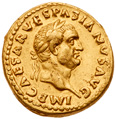 |
Vespasian. Gold Aureus (7.05 g), AD 69-79. 'Judaea Capta' type. Lugdunum mint, AD 69/70. - The exceptional portrait and reverse details, point to Lugdunum as the mint of issue. IMP CAESAR VESPASIANVS AVG, laureate head of Vespasian right. Reverse: IVDAEA in exergue, Jewess seated right, head resting on hand in attitude of mourning; behind, trophy. Hendin 1464; RIC 1; BMC 31-4; Calicó 643. Boldly struck and well centered. Some scrapes and scattered light marks hardly detract from the high quality of this exceptional example. Very Rare. Extremely Fine. Value $35,000 - UP
The first coin of the standard 'Judaea Capta' series. In the 'Judaea Capta' coinage, the seated personified Judaea evokes the iconographic language of the defeated and degraded prisoner. The conquered province type has its own set of gestures expressing a mournful or abject context, which are derived from Roman funerary iconography. They include an attitude formed by the resting of the chin in the hand, a pose that evokes pensiveness, uncertainty, and grief with overtones of repentance or lamentation. Additionally, the mourner is shown with hunched shoulders, and a bowed and covered head. The depiction of the personified province recollects the Biblical description of the besieged Jerusalem by the prophet Isaiah (ca. 700 BCE): "For Jerusalem is ruined, and Judah is fallen… Thy men shall fall by the sword and thy mighty in the war. And her gates shall lament and mourn, and she, being desolate, shall sit upon the ground" (Isaiah 3:8-9; 25-26).
The imposing military trophy standing to the left of the picture looms over the back of the vanquished Judaea, taunting the humiliated figure, re-enforcing the fact that the weapons used to resist Rome are now spoils to the victors; they no longer hold power.
View details and enlarged photos
|
|
Lot 199 |
 |
Vespasian. Gold Aureus (6.96 g), AD 69-79. Judaea Capta issue. Rome, AD 69/70. IMP CAESAR VESPASIANVS AVG, laureate head of Vespasian right. Reverse: IVDAEA in exergue, Jewess seated right, head resting on hand in attitude of mourning; behind, trophy. Hendin 1464; RIC 1; BMC 31-4; Calicó 643. Even wear. Pleasing Fine. Value $5,000 - UP
First coin of the standard 'Judaea Capta' series. In the 'Judaea Capta' coinage, the seated personified Judaea evokes the iconographic language of the defeated and degraded prisoner. The conquered province type has its own set of gestures expressing a mournful or abject context, which are derived from Roman funerary iconography. They include an attitude formed by the resting of the chin in the hand, a pose that evokes pensiveness, uncertainty, and grief with overtones of repentance or lamentation. Additionally, the mourner is shown with hunched shoulders, and a bowed and covered head. The depiction of the personified province recollects the Biblical description of the besieged Jerusalem by the prophet Isaiah (ca. 700 BCE): "For Jerusalem is ruined, and Judah is fallen… Thy men shall fall by the sword and thy mighty in the war. And her gates shall lament and mourn, and she, being desolate, shall sit upon the ground" (Isaiah 3:8-9; 25-26).The imposing military trophy standing to the left of the picture looms over the back of the vanquished Judaea, taunting the humiliated figure, re-enforcing the fact that the weapons used to resist Rome are now spoils to the victors; they no longer hold power.
Ex Mel Wacks Collection; Purchased from Jacques Schulman, Amsterdam, ca. 1960s.
View details and enlarged photos
|
|
Lot 200 |
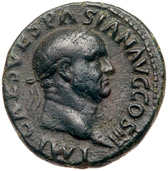 |
Vespasian. Æ As (10.15 g), AD 69-79. Judaea Capta type. Rome, AD 71. IMP CAES VESPASIAN AVG COS III, laureate head of Vespasian right. Reverse: VICTOR AVGVSTI, S C across field, Victory standing left, attaching shield to trophy beneath which Judaea seated left. Hendin 1556b; Hendin GBC 4, 783 (this coin illus.); RIC 332; BMC 615. Very Rare. Dark reddish-brown patina. Choice Very Fine. Value $2,000 - UP
Ex David Hendin Collection.
View details and enlarged photos
|
|
Lot 201 |
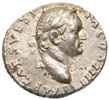 |
Vespasian. Silver Denarius (3.34 g), AD 69-79. Judaea Capta type. Antioch, AD 72/3. IMP CAES VESP AVG P M COS IIII, laureate head of Vespasian right. Reverse: Jewess seated right beneath palm-tree, head resting on hand in attitude of mourning; behind, emperor standing right, resting foot on helmet, holding spear and parazonium. Hendin 1490; RIC 1558; RPC 1930; BN 319; BMC 510; RSC 645. Rare. A few tiny deposits scattered about. An unusually sharply struck example from this eastern mint. As usual, on a slightly porous planchet. Superb Extremely Fine. Value $3,000 - UP
View details and enlarged photos
|
|
Lot 202 |
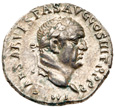 |
Vespasian. Silver Denarius (3.43 g), AD 69-79. Judaea Capta type. Ephesus, AD 71. IMP CAESAR VESPAS AVG COS III TR P P P, laureate head of Vespasian right. Reverse: PACI AVGVSTAE, Victory advancing right, holding wreath and palm; at her feet to right, E(PH)E. RIC 1431; RPC 833; BMC 457; BN 352; RSC 276. Lustrous surfaces and perfectly centered. Superb Extremely Fine. Value $2,000 - UP
View details and enlarged photos
|
|
Lot 203 |
 |
Vespasian. Silver Denarius, AD 69-79. Judaea Capta type. Rome, AD 69/70. IMP CAESAR VESPASIANVS AVG, laureate head of Vespasian right. Reverse: IVDAEA in exergue, Jewess seated right, head resting on hand in attitude of mourning; behind, trophy. Hendin 1479; RIC 2; BN 23-5; BMC 36-7; RSC 226. Toned. Choice Very Fine. Value $750 - UP
Ex David Hendin Collection.
View details and enlarged photos
|
|
Lot 204 |
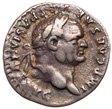 |
Vespasian. Silver Denarius, AD 69-79. Judaea Capta type. Rome, AD 79. IMP CAESAR VESPASIANVS AVG, laureate head of Vespasian right. Reverse: TR POT X COS VIIII, Victory standing left, attaching shield to trophy beneath which captive seated left. Hendin 1485; Hendin GBC 4, 741 (this coin illus.); RIC 1068; BN 214-5; BMC 246-7; RSC 552. Scarce. Toned. Very Fine. Value $400 - UP
Ex David Hendin Collection.
View details and enlarged photos
|
|
Lot 205 |
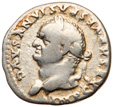 |
Vespasian. Silver Denarius (3.12 g), AD 69-79. Judaea Capta type. Rome, AD 79. IMP CAESAR VESPASIANVS AVG, laureate head of Vespasian left. Reverse: TR POT [X?] COS VIIII, Victory standing left, attaching shield to trophy beneath which captive seated left. Hendin 1485a; RIC 1069; BN 216; BMC 248; RSC 553. Lightly toned. Fine. Value $200 - UP
Possibly an engraver's error lacking the Roman numeral X in the reverse legend, or perhaps the number was filled on the die.
Ex David Hendin Collection.
View details and enlarged photos
|
|
Lot 206 |
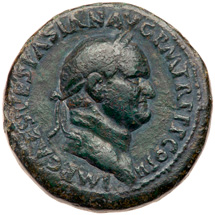 |
Vespasian. Æ Sestertius (25.45 g), AD 69-79. Judaea Capta type. Rome, AD 71. IMP CAES VESPASIAN AVG P M TR P P P COS II[I], laureate head of Vespasian right. Reverse: IVDAEA CAPTA, S C in exergue, palm tree; to left, bound captive standing right before pile of arms; to right, Judaea seated right in attitude of mourning. Hendin 1500; Hendin GBC 4, 775 (this coin illus.); RIC 159; BN 489-90; BMC 532-3. Some smoothing in the fields. Dark greenish-brown patina. Very Fine. Value $4,000 - UP
Ex David Hendin Collection.
View details and enlarged photos
|
|
Lot 207 |
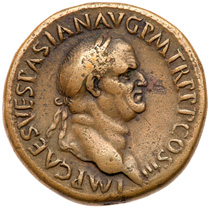 |
Vespasian. Æ Sestertius (25.7 g), AD 69-79. Judaea Capta type. Rome, AD 71. IMP CAES VESPASIAN AVG P M TR P P P COS III, laureate head of Vespasian right. Reverse: IVDAEA CAPTA, S C in exergue, palm tree; to left, bound captive standing right before pile of arms; to right, Judaea seated right in attitude of mourning. Hendin 1500; Hendin GBC 4, 773 and GBC 2, 201 (this coin illus.); RIC 159; BN 489-90; BMC 532-3. Pleasing brown and tan patina. Choice Very Fine. Value $2,500 - UP
Ex David Hendin Collection.
View details and enlarged photos
|
|
Lot 208 |
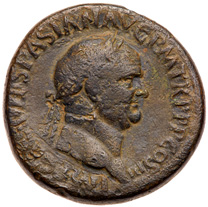 |
Vespasian. Æ Sestertius (25.72 g), AD 69-79. Judaea Capta type. Rome, AD 71. IMP CAES VESPASIAN AVG P M TR P P P COS III, laureate head of Vespasian right. Reverse: CAPTA IVDAEA, S C in exergue, palm tree; to left, bound captive standing right before pile of arms; to right, Judaea seated right in attitude of mourning. Hendin 1500c, plate coin illus; RIC 162; BN -; BMC -. uniform olive-brown patina. Very Fine. Value $2,000 - UP
Ex David Hendin Collection.
View details and enlarged photos
|
|
Lot 209 |
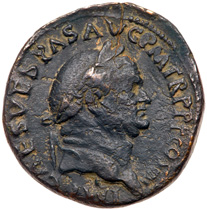 |
Vespasian. Æ Sestertius (27.01 g), AD 69-79. Judaea Capta type. Rome, AD 71. IMP CAES VESPAS AVG P M TR P P P COS III, laureate head of Vespasian right. Reverse: IVDAEA CAPTA, S C in exergue, palm tree; to left, emperor standing right, resting foot on helmet; holding spear and parazonium; to right, bound captive standing left before pile of arms. Hendin 1517, this coin being illus RIC -;; H.A. Cahn, Published in Numismatic Chronicle 1946 "Flavia Inedita," 8, pl. I, 5; BN -; BMC -. Extremely Rare reportedly the second known specimen. Black patina. Flan crack near 6 o'clock. Very Fine. Value $7,500 - UP
Ex David Hendin Collection; Ex Robert Schonwalter Collection (Triton V, 16 January 2002); Ex M & M Sale 180 (1958), #53.
View details and enlarged photos
|
|
Lot 210 |
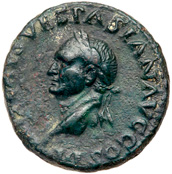 |
Vespasian. Æ As (11.37 g), AD 69-79. Judaea Capta type. Rome, AD 71. IMP CAES VESPASIAN AVG COS III, laureate head of Vespasian facing left. Reverse: VICTORIA NAVALIS, S C across field, Victory standing right on prow, holding wreath and palm. Hendin -; RIC 338; BMC 792. Rare. Mottled emerald-green patina. Nearly Extremely Fine. Value $2,000 - UP
View details and enlarged photos
|
|
Lot 211 |
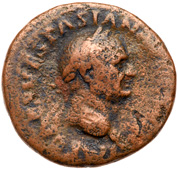 |
Vespasian. Æ As (11.57 g), AD 69-79. Judaea Capta type. Rome, AD 71. IMP CAES VESPASIAN AVG COS III, laureate head of Vespasian right. Reverse: [IVDEA] CAPTA, S C across field, Jewess seated left in attitude of mourning beneath palm tree; to right, helmet. Hendin 1554d, this being the plate coin; RIC 307; BN 584; BMC 609. Very Rare. Medium reddish-brown patina. Fine. Value $500 - UP
Ex David Hendin Collection.
View details and enlarged photos
|
|
Lot 212 |
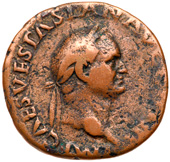 |
Vespasian. Æ As (9.40 g), AD 69-79. Judaea Capta type. Rome, AD 71. IMP CAES VESPASIAN AVG COS III, laureate head of Vespasian right. Reverse: IVDEA CAPTA, S C in exergue, Jewess seated right, head resting on hand in attitude of mourning, beneath palm tree; at foot of palm to left, various arms. Hendin 1561; Hendin GBC 2, 210 (this coin illus.); RIC 305; BMC 605. Very Rare. Brassy light reddish-brown patina. Nice Fine. Value $400 - UP
Ex David Hendin Collection; Ex Sternberg (Zurich) purchase.
View details and enlarged photos
|
|
Lot 213 |
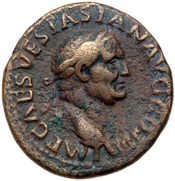 |
Vespasian. Æ As (11.55 g), AD 69-79. Judaea Capta type. Rome, AD 71. IMP CAES VESPASIAN AVG COS III, laureate head of Vespasian right. Reverse: VICTORIA NAVALIS, S C in exergue, Victory standing right on prow, holding wreath and palm. Hendin -; RIC 335; BMC 617. Mottled brown patina. Very Fine. Value $300 - UP
Ex David Hendin Collection.
View details and enlarged photos
|
|
Lot 214 |
 |
Vespasian. Æ Quadrans (1.67 g), AD 69-79. Judaea Capta type. Rome, AD 72/3. IMP VESPASIAN AVG, palm tree. Reverse: P M TR P P P COS IIII, S C across field, vexillum. Hendin 1571, this being the plate coin; RIC 408; BMC 626. Green patina with earthen highlights. Choice Very Fine. Value $400 - UP
Ex David Hendin Collection.
View details and enlarged photos
|
|
Lot 215 |
 |
Vespasian. Æ Quadrans (2.38 g), AD 69-79. Judaea Capta type. Rome, AD 71. IMP CAES VESPASIAN AVG, trophy. Reverse: PON M TR P P P COS III, S C across lower field, crossed spears flanked by two round shields. Hendin 1567 and Hendin GBC 4, 784a (this coin illus.); RIC 345; BN 599. Reddish-brown patina. Choice Very Fine. Value $400 - UP
Ex David Hendin Collection.
View details and enlarged photos
|
|
Lot 216 |
 |
Vespasian. Æ Quadrans (2.43 g), AD 69-79. Judaea Capta type, Rome, AD 71. IMP CAES VESPASIAN AVG, palm tree. Reverse: PON M TR P P P COS III, S C across field, vexillum. Hendin 1571; Hendin GBC 4, 784 (this coin illus.); RIC 340; BN 601-2. Reddish-brown patina. Very Fine. Value $350 - UP
Ex David Hendin Collection.
View details and enlarged photos
|
|
Lot 217 |
 |
Titus. Gold Aureus (7.36 g), as Caesar, AD 69-79. Rome, under Vespasian, AD 75. T CAESAR IMP VESPASIAN, laureate head of Titus right. Reverse: COS IIII, bull butting right. RIC 780; BN 146; BMC 171; Calicó 731. Amazing bold strike, magnificent bold portrait. Lustrous and perfectly struck on a full broad flan. Superb Extremely Fine. Value $25,000 - UP
Ex Peus 366 (25 October 2000), 1332; Ex Sternberg XIX (18 November 1987), 590.
View details and enlarged photos
|
|
Lot 218 |
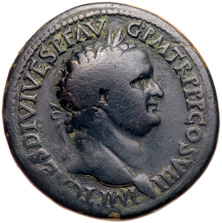 |
Titus. Æ Sestertius (24.73 g), AD 79-81. Judaea Capta type. Thracian mint, AD 80/1. IMP T CAES DIVI VESP F AVG P M TR P P P COS VIII, laureate head of Titus right. Reverse: IVDAEA CAPTA, S C in exergue, palm tree; to left, emperor standing right, resting foot on helmet, holding spear and parazonium; to right, Judaea seated right in attitude of mourning. Hendin 1597 (this coin illus.); RIC 502; RPC -. Very Rare. Fields smoothed. Glossy slate-brown patina. Very Fine. Value $3,500 - UP
Ex David Hendin Collection; Ex Hirsch 236 (23 September 2004), 2222.
View details and enlarged photos
|
|
Lot 219 |
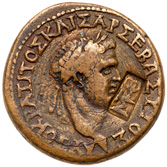 |
Titus. Æ 25 (12.27 g), as Caesar, AD 69-79. Judaea Capta type. Konon of Bithynia. M. Salvidenus Asprenas, proconsul. Laureate head of Titus right; c/m: MHTB within rectangular incuse. Reverse: Palm tree with various arms around. Hendin 1576a this being the plate coin and Hendin GBC 4, 794a (this coin illus.); RPC 612; RG 13; Stumpf 381; SNG von Aulock 274; Howgego 612. Very Rare. Light reddish-brown patina. Very Fine. Value $2,500 - UP
Ex David Hendin Collection.
View details and enlarged photos
|
|
Lot 220 |
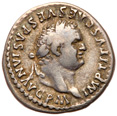 |
Titus. Silver Denarius (3.22 g), AD 79-81. Judaea Capta type. Rome, AD 80. IMP TITVS CAES VESPASIAN AVG P M, laureate head of Titus right. Reverse: TR P IX IMP XV COS VIII P P, trophy flanked by Judaea, on left, seated left in attitude of mourning, and bound Jew on right. Hendin 1584; Hendin GBC 4, 788 and GBC 2, 215 (this coin illus.); RIC 102; BMC 37; RSC 306. Pleasing old cabinet toning. Very Fine. Value $300 - UP
Ex David Hendin Collection.
View details and enlarged photos
|
|
Lot 221 |
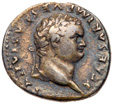 |
Titus. Silver Denarius (3.27 g), AD 79-81. Judaea Capta type. Rome, AD 79. IMP TITVS CAES VESPASIAN AVG P M, laureate head of Titus right. Reverse: TR P VIIII IMP XV COS VII P P, trophy beneath which bound captive Jew kneeling right. Hendin 1583b; RIC 49; BN 28-9; BMC 31; RSC 295. Some light scratches in the reverse field. Nice old cabinet tone. Very Fine. Value $300 - UP
Ex David Hendin Collection.
View details and enlarged photos
|
|
Lot 222 |
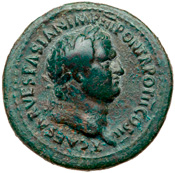 |
Titus. Æ As, as Caesar, AD 69-79. Judaea Capta type. Rome, under Vespasian, AD 72. T CAESAR VESPASIAN IMP III PON TR POT II COS II, laureate head of Titus right. Reverse: VICTORIA AVGVST, S C in exergue, Victory standing right, crowning standard with wreath. Hendin -; RIC 485; BMC 651. Beautiful hard emerald-green patina. Well struck in high relief and perfectly centered on a perfectly round flan. A marvelous example. Nearly Extremely Fine. Value $1,500 - UP
Ex David Hendin Collection.
View details and enlarged photos
|
|
Lot 223 |
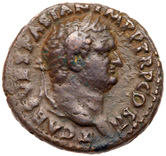 |
Titus. Æ As (9.89 g), as Caesar, AD 69-79. Judaea Capta type. Rome, under Vespasian, AD 72. T CAES VESPASIAN IMP P TR P COS II, laureate head of Titus right. Reverse: VICTORIA NAVALIS, S C across field, Victory standing right on prow, holding wreath and palm. Hendin -; RIC 454; BN 637; BMC 645A. Reddish-brown patina. Choice Very Fine. Value $600 - UP
Ex David Hendin Collection.
View details and enlarged photos
|
|
Lot 224 |
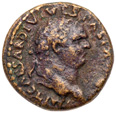 |
Titus. Æ Semis (4.50 g), AD 79-81. Judaea Capta type. Thracian mint(?), AD 80/1. IMP T CAESAR DIVI VESPAS F AVG, laureate head of Titus right. Reverse: IVD CAP/S C across field in two lines, Judaea, in attitude of mourning, seated left beneath palm tree; to right, arms. Hendin 1598; RIC 504; RPC -. Very Rare. Reddish-brown tone. Very Fine. Value $2,500 - UP
Ex NAC 40 (16 May 2007), 334; Ex Abraham Bromberg Collection, pt. I (Superior, 5 December 1991), 313.
View details and enlarged photos
|
|
Lot 225 |
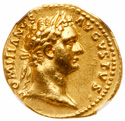 |
Domitian. Gold Aureus (6.97 g), AD 81-96. Rome, AD 92-94. DOMITIANVS AVGVSTVS, laureate head of Domitian right. Reverse: GERMANICVS COS XVI, Germania seated right atop shield, resting head on hand in attitude of mourning; below, broken spear. RIC 747; BN 187; BMC 211; Calicó 854. Nice centering allowing for all of the design and a majority of the beaded border to be visible. NGC grade AU; Strike: 5/5, Surface: 3/5. Value $15,000 - UP
View details and enlarged photos
|
|
Lot 226 |
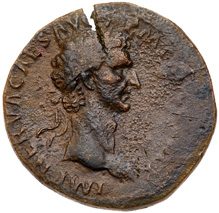 |
Nerva. Æ Sestertius (25.40 g), AD 96-98. Rome, AD 97. IMP NERVA CAES AVG P M T[R P COS III] P P, laureate head of Nerva right. Reverse: FISCI IVDAICI [CALVMNIA SVBL]ATA, S C across field, palm tree with two large bunches of dates. Hendin 1603; RIC 82; BN 97; BMC 105. Uniform reddish brown patina. Flan crack but with all important details clear. Very Fine. Value $4,000 - UP
According to the Roman historian Suetonius: "More than any other, the Fiscus Iudaicus was administered very severely; and to it were brought, or reported, those who either had lived the life of a Jew unprofessed, or concealing their origin, had not paid the tax imposed upon by the people. I remember that it was of interest to me during my youth when a ninety-year-old man was brought before the procurator and a very crowded court to see wheather he was circumcised."
Marius Heemstra, in a recent article, challenges the earlier interpretation of the reverse inscription. "The embarrassment (CALVMNIA) of the Jewish Tax (FISCI IVDAICI) is removed," ie., that the Jewish tax, which had been introduced by Vespasian after the destruction of the Temple in Jerusalem, was repealed by Nerva, in whole or in part. Heemstra also disagrees with the theory that the CALVMNIA, was "the circumcision test" described by Suetonius (Dom. 12.1-2). Rather, Heemstra maintains that the tax was not repealed, but, rather, that the legend should be translated: "The removal of the wrongful accusation (CALVMNIA) of the Fiscus Judaicus (the imperial tax collection agency)."
What was the CALVMNIA? Meestra explains that before the "removal" of the "wrongful accusation," by Nerva, it is highly plausible that the charge of 'leading a Jewish life without publicly acknowledging that fact' could have been levied against high-ranking Romans who could then have been victims of the Fiscus Judaicus, which would confiscate their wealth. Conviction could occur either on political grounds, instigated by the emperor himself (Domitian), or because any affiliation with Judaism, however, small could lead to an accusation of "atheism," which to Romans meant not recognizing their pagan gods.
Meestra points out that an important impact of the new law was that it necessitated a clarification in the definition of who was the taxpayer, and, thus who was considered to be a Jew. Instead of "each one of the Jew"s (Josephus), or, "those belonging to the Jewish gens" (Suetonius), the definition changed to "those Jews who continued to observe their ancestral customs" (Dio). In practice, these were the Jews that had been paying the tax in the first place.
By removing the CALVMNIA "the wrongful accusation," Nerva succeeded in transforming the definition of 'Jew' from an ethnic one into a religious one, which both the Romans and Jews adopted. Regardless, this coin represents Nerva's order not to abolish the tax itself but of the insulting method of collecting the Jewish tax.
See discussion in: Marius Heemstra, "The interprretation and Wider Context of Nerva's Fiscus Judaicus Sestertius, Judaea and Rome in Coins 65 BCE - 135 CE, London: Spink and Sons, 2010, 187-201.
Ex Mel Wacks Collection; Purchased from Tom Donner of New York, Aug. 1966.
View details and enlarged photos
|
|
Lot 227 |
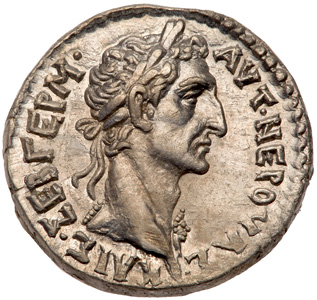 |
Nerva. Silver Tetradrachm (15.41 g), AD 96-98. Antioch in Syria, New Holy Year 2 (AD 97/8). Laureate bust of Nerva right, aegis at point of bust. Reverse: Eagle standing facing, head right, wings displayed, on thunderbolt. McAlee 420; Prieur 150; RPC 3477. Incredible portrait. Probably the finest known example. Mint State. Value $3,000 - UP
The Roman emperor Nerva came from a distinguished family that was connected to the Julio-Claudian dynasty through marriage. He served under Nero and was instrumental in uncovering the Pisonian conspiracy in AD 65, and subsequently served under each of the three Flavian emperors in turn. Upon Domitian's assassination in AD 96, the Senate proclaimed Nerva emperor solely on their own initiative, the first such instance of the Senate exercising this prerogative during imperial times. Upon his accession Nerva attempted to appease the Senate by ending Domitian's proscriptions and promising a general amnesty to the conspirators, stating he would not have any senators put to death. Additionally, he paid a large donative amounting to 5000 denarii a head to the Praetorian Guard. However, the Praetorians were dissatisfied, and in October AD 97 they laid siege to the Imperial Palace and took Nerva hostage. They demanded that the emperor hand over those responsible for Domitian's death, who were swiftly executed, and then forced Nerva to give a speech publicly thanking them. This event damaged the emperor's authority beyond repair, and shortly thereafter Nerva adopted as heir the popular general of the German frontier, Marcus Ulpius Traianus. With this accomplished, Nerva all but abdicated the throne, dying only three months later (January AD 98).
View details and enlarged photos
|
|
Lot 228 |
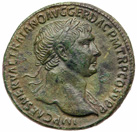 |
Trajan. Æ Sestertius (25.57 g), AD 98-117. Rome. IMP CAES NERVAE TRAIANO AVG GER DAC PM TR P COS V P P, laureate bust of Trajan right, slight drapery on far shoulder. Reverse: S P Q R OPTIMO PRINCIPI, S C in exergue, emperor in military attire on horseback charging right, brandishing spear at Dacian on his knees below. RIC 534; Woytek 203b; BN 405; BMC 839. Large flan. Brownish-green patina, slightly smoothed on reverse. A very handsome example. About Extremely Fine. Value $1,000 - UP
Ex New York Sale XXIII (6 January 2010), 159.
View details and enlarged photos
|
|
|
|